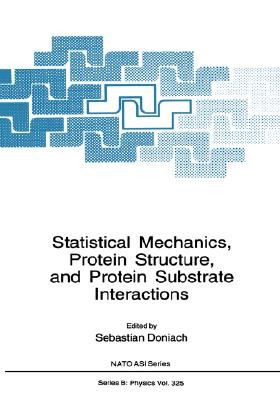
- We will send in 10–14 business days.
- Publisher: Springer
- ISBN-10: 0306447282
- ISBN-13: 9780306447280
- Format: 17.8 x 25.4 x 2.4 cm, hardcover
- Language: English
- SAVE -10% with code: EXTRA
Statistical Mechanics, Protein Structure, and Protein Substrate Interactions (e-book) (used book) | bookbook.eu
Reviews
Description
A number of factors have come together in the last couple of decades to define the emerging interdisciplinary field of structural molecular biology. First, there has been the considerable growth in our ability to obtain atomic-resolution structural data for biological molecules in general, and proteins in particular. This is a result of advances in technique, both in x-ray crystallography, driven by the development of electronic detectors and of synchrotron radiation x-ray sources, and by the development ofNMR techniques which allow for inference of a three-dimensional structure of a protein in solution. Second, there has been the enormous development of techniques in DNA engineering which makes it possible to isolate and clone specific molecules of interest in sufficient quantities to enable structural measurements. In addition, the ability to mutate a given amino acid sequence at will has led to a new branch of biochemistry in which quantitative measurements can be made assessing the influence of a given amino acid on the function of a biological molecule. A third factor, resulting from the exponential increase in computing power available to researchers, has been the emergence of a growing body of people who can take the structural data and use it to build atomic-scale models of biomolecules in order to try and simulate their motions in an aqueous environment, thus helping to provide answers to one of the most basic questions of molecular biology: the relation of structure to function.
EXTRA 10 % discount with code: EXTRA
The promotion ends in 17d.08:58:20
The discount code is valid when purchasing from 10 €. Discounts do not stack.
- Publisher: Springer
- ISBN-10: 0306447282
- ISBN-13: 9780306447280
- Format: 17.8 x 25.4 x 2.4 cm, hardcover
- Language: English English
A number of factors have come together in the last couple of decades to define the emerging interdisciplinary field of structural molecular biology. First, there has been the considerable growth in our ability to obtain atomic-resolution structural data for biological molecules in general, and proteins in particular. This is a result of advances in technique, both in x-ray crystallography, driven by the development of electronic detectors and of synchrotron radiation x-ray sources, and by the development ofNMR techniques which allow for inference of a three-dimensional structure of a protein in solution. Second, there has been the enormous development of techniques in DNA engineering which makes it possible to isolate and clone specific molecules of interest in sufficient quantities to enable structural measurements. In addition, the ability to mutate a given amino acid sequence at will has led to a new branch of biochemistry in which quantitative measurements can be made assessing the influence of a given amino acid on the function of a biological molecule. A third factor, resulting from the exponential increase in computing power available to researchers, has been the emergence of a growing body of people who can take the structural data and use it to build atomic-scale models of biomolecules in order to try and simulate their motions in an aqueous environment, thus helping to provide answers to one of the most basic questions of molecular biology: the relation of structure to function.


Reviews